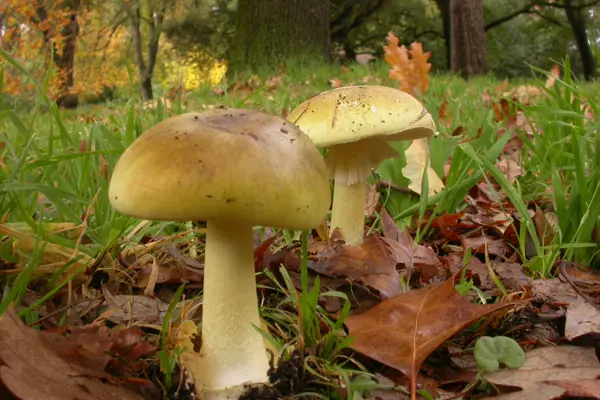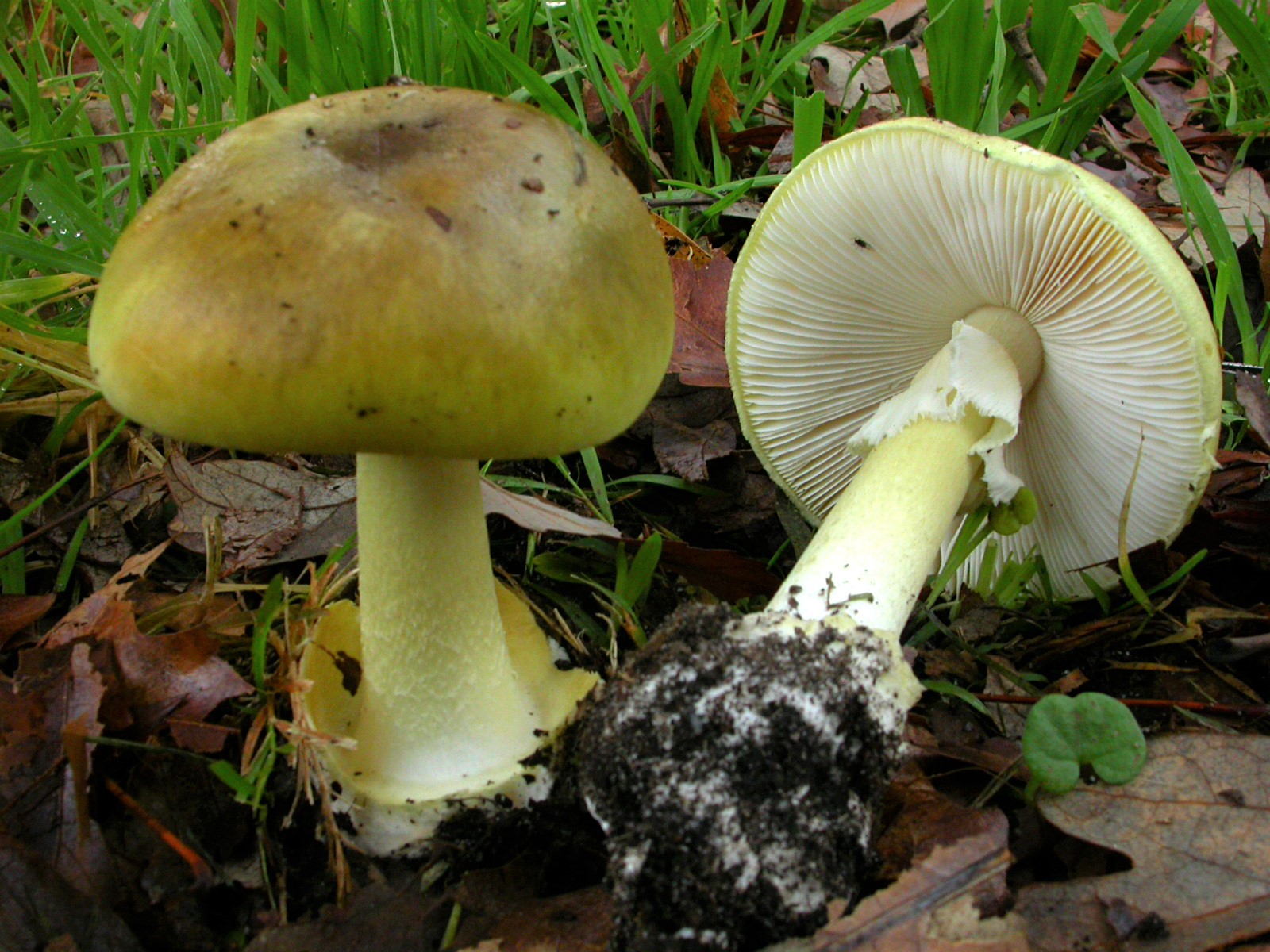
Death Cap –Amanita phalloides
Death Cap – Amanita phalloides
Amanita phalloides (Death Cap) is a highly poisonous mushroom that grows under oak trees in parks and gardens.
Distinctive characters
Amanita phalloides may be recognised by the following features:
- pileus (cap) whitish, yellow, pale brown or green
- lamellae (gills) white
- spore print white
- volva (cup) present at base of stipe
- annulus (ring) present on stipe
- occurs under oak tree.

Amanita phalloides showing volva at base of stipe (left) and underside with pale lamellae and annulus on stipe (right).
Symptoms and treatment
The Death Cap is aptly named—it is deadly poisonous. The toxin is not inactivated by cooking. Symptoms of poisoning are typically delayed and do not appear for 6–12 (and up to 24–36) hours after ingestion. Initial symptoms are abdominal cramps, vomiting and diarrhoea. These symptoms may subside for a period, but eventually there is a high mortality due to organ damage, particularly liver failure.
For treatment, contact the Poisons Information Centre (13 1126).
Description
Pileus: 40–160 mm diameter, hemispherical, then convex, eventually expanding to plane, smooth, viscid when wet, shiny when dry, usually pale yellow or greenish, to pale brown, but can be almost white especially when unopened. Smooth or with large white membranous patches from universal veil.
Lamellae: white, crowded, free from the stipe.
Stipe: 50–130(–180) mm high, 10–20(–30) mm diameter, white, with a membranous annulus (can disappear in age), base bulbous with a saccate volva (a membranous cup of tissue at the base of the stem).
Spore print: white.
Odour: not distinctive at first, strong and unpleasant, especially on drying.
The whole fruit body is initially covered by a white membrane (the universal veil). As the pileus expands, this disrupts to form the cup-shaped volva at the stipe base, and sometimes leaves patches of tissue on the pileus surface. If in doubt about the presence of the volva, make sure that the stipe base is intact and if necessary dig down to inspect the entire fruit-body.
Habitat, host and distribution
Habitat: in parks, gardens, and nature strips.
Host: always under exotic trees, especially Oak (Quercus), including broad-leaved and cut-leaved oaks. There are reports of Amanita phalloides growing under Eucalyptus in Algeria and Tanzania, but there are no confirmed sightings of the Death Cap away from exotic trees in Australia.
Substrate: on the ground, among leaf litter or in garden beds or lawns.
Distribution: in Australia only recorded from South Australia, Victoria and the Australian Capital Territory (Canberra).
In Victoria, Death Cap occurs widely across Melbourne in suburbs including Ashburton, Burwood, Camberwell, Canterbury, Clayton, Deepdene, East Malvern, Emerald, Heathmont, Heidelberg, Kew, Sandringham, South Yarra, Surrey Hills and Wheelers Hill. In regional Victoria, Death Cap has also been reported from Bendigo, Bright, Castlemaine, Gisbourne and Wandiligong. Death Cap can be expected to occur anywhere in Victoria where oaks are planted.
Death Cap was first confirmed from Australia in the 1960s, but may have been undetected prior to that. First noted in Canberra in the 1960s, in Melbourne in the 1970s and in Adelaide in 2008.
Time of appearance: autumn and sometimes winter. Fruit bodies are abundant in wet autumns, but may not appear in drier years.
Biology: grows symbiotically with trees (mycorrhizal), to the benefit of both tree and fungus.
Similar species
Native species of Amanita that share with A. phalloides the saccate volva, membranous ring and amyloid spores are Amanita austrophalloides, A. marmorata (which also occurs as an exotic under Eucalyptus in Hawaii), A. murina and A. murinaster. Toxicity of these native species is unknown, but due to their close relationship to A. phalloides, they could well turn out to be highly toxic. Leucoagaricus naucinus has white lamellae, an annulus on the stipe, and grows in lawns and gardens. However, it is not especially associated with oaks, the pileus is never greenish and, although the stipe base is bulbous, there is no volva.
